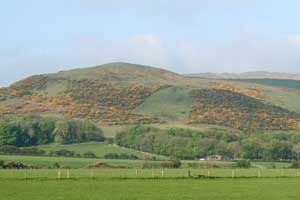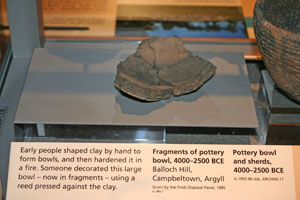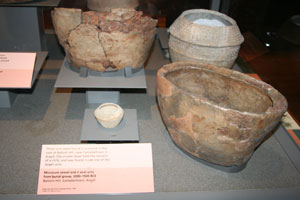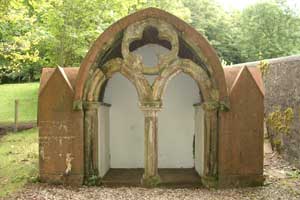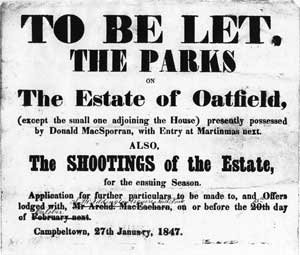
 |
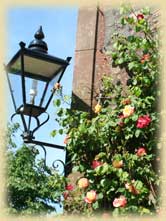 |
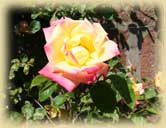 |
Oatfield House is tucked away in a well chosen and notably sheltered position in the trees at the bottom right hand corner of the above photograph. Immediately behind is Bealloch (or Balloch - Gaelic for the "Pass") Hill, which has traces of ancient ruins and an Iron Age hill fort at the top. Occupied for at least some 6,000 years, it was excavated in 1985 by archeologists from Edinburgh University, led by Professor Peltenberg. Finds included flints, fragments of jewelry and of Neolithic pottery (see below).
This Neolithic pottery, dating from between 4,500 to 6,000 years ago was found near the fort and is seen here on display at the newly refurbished Kelvingrove Museum in Glasgow in 2006. Also on display and found in a crevice within the fort...
were a unique pair of Bronze Age oval burial urns with a small third bowl containing the remains of a child, found within one of the larger urns.
Evidence of occupation of the hill continued through the Bronze and into the Iron age, when the main fort was built. Originally started as a proper fortification, it seems that the immediate threat must have disappeared, for it was completed as more of a status symbol, than as a serious defence.
In around 500 AD, this part of what is now Scotland was invaded by the Scots from Ireland, who eventually gave it their name and formed the Kingdom of Dalraida. Their King, Fergus Mor McErc, is still commemorated in the name of the far hill in the top photograph, Tirfergus (Gaelic for Fergus's Land).
Following the time line, although rather out of context, the next piece of tangible history at Oatfield is a 13th century fragment of ecclesiastical stonework, made into a folly.
Originally part of Dunblane Cathedral, this was brought here during the time of its restoration in the late 1800s by Alexander Fleming, a Victorian Philanthropist who was the Laird of Oatfield (and other lands) at that time. A handwritten poem may be seen at the House commemorating this.
The first written record of the Achachoirk (Gaelic for Oatfield) Estate that we have been able to find, appears in 1499 when it is noted that a Gillespie McEachran had the freehold of Achequhork (Kintyre Antiquarian Society records).
The earliest published map reference is on the Map of Kintyre, by Gordon, circa 1637. Achnachork (spelling, as you may have noticed by now, was always a little fluid in those days) seems to have moved a little to the east since then, but its position is at least as accurate as the rest of the map!
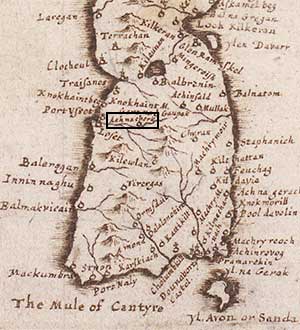
Ownership of the estate, as with the rest of Kintyre after the unfortunate MacDonald backing of the wrong side in the Civil War (ending in the bloody massacre of 300 MacDonalds at Dunaverty in 1647 by General Leslie), was then forfeited to the Dukes of Argyll and it was not again in private hands until it was sold as "2 merk land of Achachoirk in the Parish of Kilkivan" to John Elder, of Bellymaconalin, County Antrim, in 1702.
We understand that the present House was built in 1780 by Francis Farquharson of Clachaig, who bought the estate from the Elders in 1760. But he went bankrupt in 1785 (perhaps as a consequence of over extending himself in building the House?) and we suspect that it was not actually completed until the 1790s, by Archibald Farquharson of Finzean, who bought it from Francis's creditors in 1791. In 1816, Archibald Farquharson then sold the estate to Captain Colin McEachern.
A merchant sea captain born nearby, Colin had the great good fortune to capture a French ship during the Napoleonic Wars and the prize money made him relatively wealthy. He lived here with his wife and two daughters and mention is made in various writings of the time of people visiting between here and their own fine houses nearby.
Colin died in 1845 and the House passed to his Daughter, Elizabeth, although it appears to have been let, as can be seen from the following notice...
During the following years, the House was let to various tenants including the Donald MacSporran mentioned in the letting notice, a Donald McKay J.P. and a Colonel Frederick Lumley. In 1872 it was bought by a local man, John Campbell McNaughton. On his death only seven years later, it was passed on to his elder brother and then, in 1889, to a William Henry McNaughton of Illinois, who advertised it the following year for the sum of £5,000 and sold it to Alexander Fleming.
Alexander Fleming
Born at Ballyvain in 1824, Alexander Fleming was a local boy who had gone to Glasgow and eventually become a partner and Ironmaster in the firm of William Baird & Co Ltd, Glasgow. This had made him a wealthy man and he bought Kilmaho and Oatfield estates and made Oatfield House, which he had substantially extended, his country home, his main residence being in Glasgow. A noted philanthropist, Mr Fleming invested a great deal in Campbeltown and in making his estates model farms in the interests of the tenants and labourers.
Upon his death in 1909, Oatfield was bequeathed to his grand-nephew Alexander Meikle, a farmer at Girvan. But the actual occupancy of the House was given in liferent to Alexander Fleming's five nieces, daughters of his elder brother, William.
Oatfield House in 1910
The sixth niece had died in 1890, but not before giving birth to a daughter, Mary Fleming Gilchrist, who came to live with her five maiden aunts at Oatfield.
Mary Fleming Gilchrist at Oatfield, circa 1901
L to R - Aunt Janet plus an unknown lady, Agnes Fleming, Mrs Clark and Aunts Jeanie and Lizzie and Tommy, the dog, at Oatfield in 1912
The visitors leaving, again in 1912
When three of the sisters had died, the other two gave up their liferent and the estate was split, with the farm being sold to William Johnston in 1928 and the House being sold a year later to James McGeachy of Clochiel. James unfortunately passed on only a year later, in 1930 and the House was again given in liferent, this time to his wife's sister, Miss Katie McCallum. Upon whose death it went to her niece, another Miss Katie McCallum. Upon whose death it went to James McGeachy Munro, who sold it in 1972.
We had the pleasure of meeting Mr Munro, seen here as a boy, seated in the foreground of this 1932 photograph.
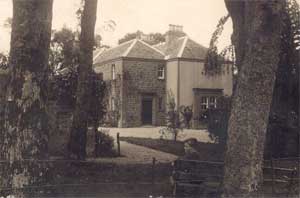
Oatfield Farm was sold on by the Johnston family in 1999 and part of it, the land immediately behind the House, was re-purchased which, together with Bealloch Hill and the land beyond, forms the present estate.
Many more photographs may be seen at the house, together with a full record of the archeological dig of the fort and a much fuller historical record of the House... for anyone that's interested!
© Copyright: L E Cowan, 2007 - 2021. All Rights Reserved.
